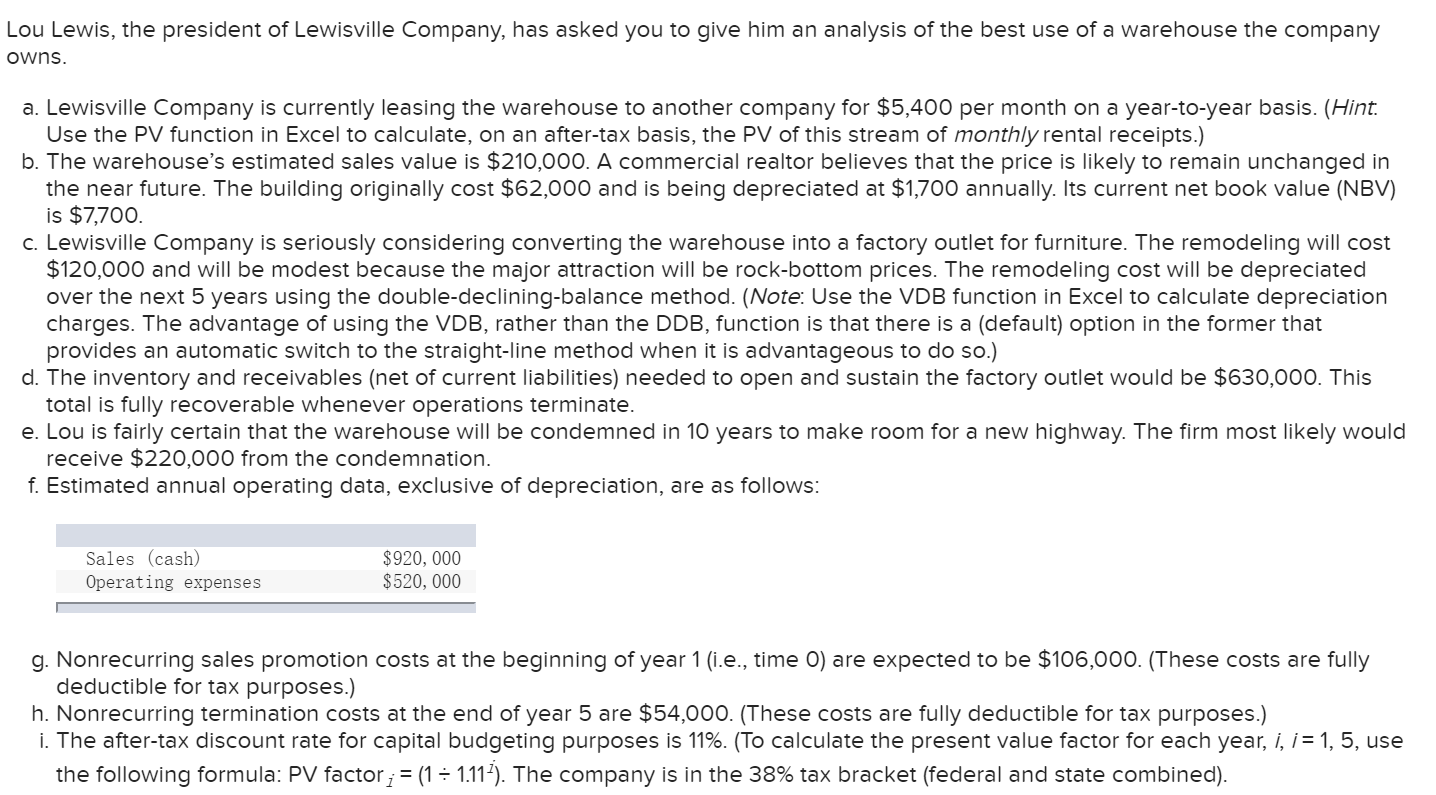


Lou Lewis, the president of Lewisville Company, has asked you to give him an analysis of the best use of a warehouse the company owns. a. Lewisville Company is currently leasing the warehouse to another company for $5,400 per month on a year-to-year basis. (Hint. Use the PV function in Excel to calculate, on an after-tax basis, the PV of this stream of monthly rental receipts.) b. The warehouse's estimated sales value is $210,000. A commercial realtor believes that the price is likely to remain unchanged in the near future. The building originally cost $62,000 and is being depreciated at $1,700 annually. Its current net book value (NBV) is $7,700. c. Lewisville Company is seriously considering converting the warehouse into a factory outlet for furniture. The remodeling will cost $120,000 and will be modest because the major attraction will be rock-bottom prices. The remodeling cost will be depreciated over the next 5 years using the double-declining-balance method. (Note: Use the VDB function in Excel to calculate depreciation charges. The advantage of using the VDB, rather than the DDB, function is that there is a (default) option in the former that provides an automatic switch to the straight-line method when it is advantageous to do so.) d. The inventory and receivables (net of current liabilities) needed to open and sustain the factory outlet would be $630,000. This total is fully recoverable whenever operations terminate. e. Lou is fairly certain that the warehouse will be condemned in 10 years to make room for a new highway. The firm most likely would receive $220,000 from the condemnation. f. Estimated annual operating data, exclusive of depreciation, are as follows: Sales (cash) Operating expenses $920, 000 $520,000 g. Nonrecurring sales promotion costs at the beginning of year 1 (i.e., time 0) are expected to be $106,000. (These costs are fully deductible for tax purposes.) h. Nonrecurring termination costs at the end of year 5 are $54,000. (These costs are fully deductible for tax purposes.) i. The after-tax discount rate for capital budgeting purposes is 11%. (To calculate the present value factor for each year, i, i = 1, 5, use the following formula: PV factor ; = (1 = 1.11?). The company is in the 38% tax bracket (federal and state combined). Required: 1. Show how you would handle the individual items in determining whether the company should continue to lease the space or convert it to a factory outlet. Use PV function in Excel, VDB function in Excel to calculate annual depreciation charges. Use NPV function to calculate depreciation tax savings. Cash Flows in Year 2 3 PV 0 1 4 5 Description After-tax monthly rent foregone All are irrelevant Remodeling cost (capitalized) Depreciation tax savings (DDB method; @38%) Investment in net working capital Recovery of net working capital After-tax cash sales After-tax cash operating expenses After-tax sales promotion cost, year 0 After-tax termination cost, year 5 NPV = Lou Lewis, the president of Lewisville Company, has asked you to give him an analysis of the best use of a warehouse the company owns. a. Lewisville Company is currently leasing the warehouse to another company for $5,400 per month on a year-to-year basis. (Hint. Use the PV function in Excel to calculate, on an after-tax basis, the PV of this stream of monthly rental receipts.) b. The warehouse's estimated sales value is $210,000. A commercial realtor believes that the price is likely to remain unchanged in the near future. The building originally cost $62,000 and is being depreciated at $1,700 annually. Its current net book value (NBV) is $7,700. c. Lewisville Company is seriously considering converting the warehouse into a factory outlet for furniture. The remodeling will cost $120,000 and will be modest because the major attraction will be rock-bottom prices. The remodeling cost will be depreciated over the next 5 years using the double-declining-balance method. (Note: Use the VDB function in Excel to calculate depreciation charges. The advantage of using the VDB, rather than the DDB, function is that there is a (default) option in the former that provides an automatic switch to the straight-line method when it is advantageous to do so.) d. The inventory and receivables (net of current liabilities) needed to open and sustain the factory outlet would be $630,000. This total is fully recoverable whenever operations terminate. e. Lou is fairly certain that the warehouse will be condemned in 10 years to make room for a new highway. The firm most likely would receive $220,000 from the condemnation. f. Estimated annual operating data, exclusive of depreciation, are as follows: Sales (cash) Operating expenses $920, 000 $520,000 g. Nonrecurring sales promotion costs at the beginning of year 1 (i.e., time 0) are expected to be $106,000. (These costs are fully deductible for tax purposes.) h. Nonrecurring termination costs at the end of year 5 are $54,000. (These costs are fully deductible for tax purposes.) i. The after-tax discount rate for capital budgeting purposes is 11%. (To calculate the present value factor for each year, i, i = 1, 5, use the following formula: PV factor ; = (1 = 1.11?). The company is in the 38% tax bracket (federal and state combined). Required: 1. Show how you would handle the individual items in determining whether the company should continue to lease the space or convert it to a factory outlet. Use PV function in Excel, VDB function in Excel to calculate annual depreciation charges. Use NPV function to calculate depreciation tax savings. Cash Flows in Year 2 3 PV 0 1 4 5 Description After-tax monthly rent foregone All are irrelevant Remodeling cost (capitalized) Depreciation tax savings (DDB method; @38%) Investment in net working capital Recovery of net working capital After-tax cash sales After-tax cash operating expenses After-tax sales promotion cost, year 0 After-tax termination cost, year 5 NPV =









